- Scientists are using Neanderthal DNA and stem cells to grow the brains
- These will be wired to a crab-like robot to discover how Neanderthals learn
- Experiment could reveal why early man died out, and homo sapiens flourished
PUBLISHED: 10:48 BST, 29 June 2018 | UPDATED: 12:10 BST, 29 June
A team of researchers hope lab-grown brains from 550,000-year-old Neanderthals will be able to pilot the movements of a crab-like robot.
The unbelievable experiment is using Neanderthal DNA to grow pea-sized brains masses, which are hooked-up to robots to test the capabilities of the electrical signals detected within the tissue.
Researchers from the University of California, San Diego (UCSD) School of Medicine are simultaneously growing brain tissue from human DNA to plug into the same crab-like machines.
They hope the difference in robot movements achieved by the lab-grown brains of modern man and Neanderthals, who diverged from human beings around 550,000 to 765,000 years ago, will offer vital clues about the minds of our early ancestors.
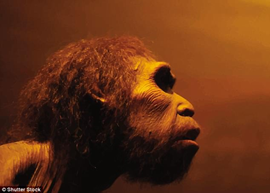
Researchers from the University of California, San Diego (UCSD) are growing brain tissue from Neanderthal DNA in the hopes of getting the minds to pilot crab-like machines (Stock Image)
The lab-grown brains cannot achieve conscious thoughts or feelings – but can mimic the basic structure of a developed brain, and reveal key differences in how the nerve cells function.
These mini brains, known as organoids, are built using stem cells.
‘We’re trying to recreate Neanderthal minds,’ said Dr Alysson Muotri, who is leading the UCSD study.
According to the researchers, studying organoids could reveal how our closest relatives differed from modern humans, and why humanity flourished while others became extinct.
Dr Muotri has yet to publish any findings from the study.
However, he revealed some early details about the work on Neanderthal organoids during a UCSD conference called Imagination and Human Evolution, which was held this month at the Salk Institute, in southern California.
According to Dr Muotri, the team has managed to coax stem cells endowed with Neanderthal DNA into pea-size masses that mimic the cortex – the outer layer of full-size brains.
The first thing the researchers noticed about their newly-grown Neanderthal brains was the shape, which was vastly different to those grown with typical human cells.
While those grown from modern-day human DNA have a spherical shape, those developed from ancient man has a ‘popcorn’-like appearance, researchers claim.
The Neanderthal neurons also make fewer synaptic connections than their modern counterparts, creating what resembles an abnormal neuronal network.
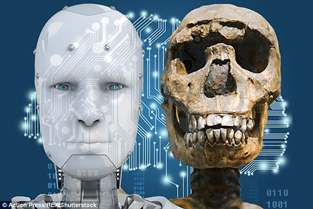
Dr Muotri and his team have managed to coax stem cells endowed with Neanderthal DNA into pea-size masses that mimic the cortex – the outer layer of full-size brains. These brain tissue masses will be plugged into crab-like machines to observe how Neanderthal brains learn
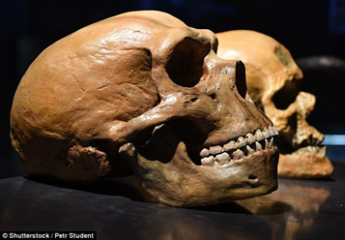
Earlier this year, a Japanese study recreated the structure of the typical Neanderthal brain for the first time, based on casts taken from fossil skulls. It revealed that Neanderthal brains were the same size as those of early human species, however, the latter had a larger cerebellum (Pictured: Stock Image of Neanderthal skull, compared to that of a modern human being)
This may have influenced the ability for the species to socialise, researchers have hinted.
Several of these differences mirror the neuronal development of children with autism.
‘I don’t want families to conclude that I’m comparing autistic kids to Neanderthals, but it’s an important observation,’ Dr Muotri clarified during the Imagination and Human Evolution keynote.
‘In modern humans, these types of changes are linked to defects in brain development that are needed for socialization. If we believe that’s one of our advantages over Neanderthals, it’s relevant.’
Dr Muotri, who has a stepson with autism, is now wiring the organoids to robots that resemble crabs – hoping the electrical signals within the tiny balls of tissue will be able to control their movements.
In the future, Dr Muotri wants to pit the Neanderthal brains against robots run by human organoids to work out the differences in how the two minds learn.
‘Ultimately, we want to compare the Neanderthalised organoid [with the human-controlled robot] to test its ability to learn,’ Dr Muotri explained.
‘By doing this systematically, we will learn what are the genetic alterations that made us uniquely human and why they were positively selected.’
HOW HAS THE SHAPE OF OUR BRAINS EVOLVED OVER TIME?
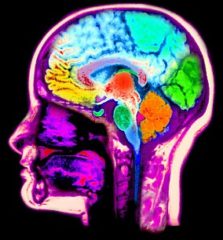
New research suggests key evolutionary changes in our brain shape occurred 100,000-35,000 years ago. Stock image
Researchers at Germany’s Max Planck Institute for Evolutionary Anthropology discovered that key evolutionary changes in our brain shape occurred roughly 100,000 to 35,000 years ago
The Homo sapiens brain took on a globe-like shape that’s ’rounder and less overhanging’
By contrast, our Neanderthal ancestors’ brains had a more elongated shape
The evolution of our brain shape coincided with major developments in behavior, as Homo sapiens began to:
- Build tools
- Develop a working and long-term memory
- Possess self-awareness
- Use language
- Plan activities
- Understand numbers
- Pay attention to their surroundings
- Develop emotions
The brain began to look more like a globe as a result of bulging in the parietal area and the cerebellum
Upon learning about the researchers plans to grow brain tissue from a 550,000 year-old ancestor, Dr Todd Preuss of the Yerkes National Primate Research Centre commented: ‘I’m a little envious.’
‘It’s still a long haul to get from organoids to real brains, but if the technique can be developed enough to give us more information about normal tissue structure, then you’ve got something that’s probably very useful,’ said Dr Preuss, who studied the differences between humans and nonhuman primates by comparing the differences in human brains and those of chimpanzees.
The team at the University of California, San Diego is not the only group of researchers hoping to unlock clues about the differences between homo sapiens and Neanderthals using organoids.
Professor Svante Pääbo, of the genetics department at the Max Planck Institute for Evolutionary Anthropology in Leipzig, Germany, is also working to create lab-grown Neanderthals minds.
Professor Pääbo, who led the team that originally deciphered the Neanderthal genome by rescuing DNA from ancient bones, hopes to compare these organoids with those created using chimpanzee and modern human cells to determine the differences between the tissue mass.
‘There are lots of control experiments to do, and then I’m quite hopeful we’ll overcome those doubts,’ Professor Pääbo added.
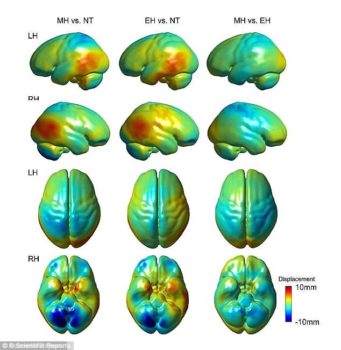
A Japanese study published in April 2018 recreated the structure of the typical Neanderthal brain for the first time, based on casts of fossil skulls. They compared the estimated sizes of Neanderthal brains to modern humans (left column) and early humans (centre column). Red indicates large shape difference while green and blue show little change
Earlier this year, a Japanese study recreated the structure of the typical Neanderthal brain for the first time, based on casts taken from fossil skulls.
While the Neanderthal brains were found to be the same size as those of early human beings, the team found that the human brain had a larger cerebellum.
This region is responsible for movement and coordination – and, according to the researchers, having more neurons in this region increases intelligence, attention, language processing and working and episodic memory – knowing or remembering, respectively.
The findings suggest humans may have had a better shot at survival based on their ability to adapt.
Scientist discusses way of life for the Neanderthal people
WHO WERE THE NEANDERTHALS?
The Neanderthals were a close human ancestor that mysteriously died out around 50,000 years ago.
The species lived in Africa with early humans for hundreds of millennia before moving across to Europe around 500,000 years ago.
They were later joined by humans taking the same journey some time in the past 100,000 years.

The Neanderthals were a close human ancestor that perished around 50,000 years ago. The species lived in Africa with early humans before moving across to Europe around 500,000 years ago. Pictured is a Neanderthal museum exhibit
These were the original ‘cavemen’, historically thought to be dim-witted and brutish compared to modern humans.
In recent years though, and especially over the last decade, it has become increasingly apparent we’ve been selling Neanderthals short.
A growing body of evidence points to a more sophisticated and multi-talented kind of ‘caveman’ than anyone thought possible.
It now seems likely that Neanderthals buried their dead with the concept of an afterlife in mind.
Additionally, their diets and behaviour were surprisingly flexible.
They used body art such as pigments and beads, and they were the very first artists, with Neanderthal cave art (and symbolism) in Spain apparently predating the earliest modern human art by some 20,000 years.